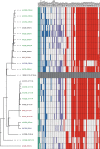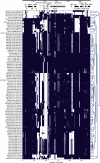Whole genome sequence analysis of Australian avian pathogenic Escherichia coli that carry the class 1 integrase gene
- PMID: 30672731
- PMCID: PMC6421350
- DOI: 10.1099/mgen.0.000250
Whole genome sequence analysis of Australian avian pathogenic Escherichia coli that carry the class 1 integrase gene
Abstract
Avian pathogenic Escherichia coli (APEC) cause widespread economic losses in poultry production and are potential zoonotic pathogens. Genome sequences of 95 APEC from commercial poultry operations in four Australian states that carried the class 1 integrase gene intI1, a proxy for multiple drug resistance (MDR), were characterized. Sequence types ST117 (22/95), ST350 (10/95), ST429 and ST57 (each 9/95), ST95 (8/95) and ST973 (7/95) dominated, while 24 STs were represented by one or two strains. FII and FIB repA genes were the predominant (each 93/95, 98 %) plasmid incompatibility groups identified, but those of B/O/K/Z (25/95, 26 %) and I1 (24/95, 25 %) were also identified frequently. Virulence-associated genes (VAGs) carried by ColV and ColBM virulence plasmids, including those encoding protectins [iss (91/95, 96 %), ompT (91/95, 96 %) and traT (90/95, 95 %)], iron-acquisition systems [sitA (88/95, 93 %), etsA (87/95, 92 %), iroN (84/95, 89 %) and iucD/iutA (84/95, 89 %)] and the putative avian haemolysin hylF (91/95, 96 %), featured prominently. Notably, mobile resistance genes conferring resistance to fluoroquinolones, colistin, extended-spectrum β-lactams and carbapenems were not detected in the genomes of these 95 APEC but carriage of the sulphonamide resistance gene, sul1 (59/95, 63 %), the trimethoprim resistance gene cassettes dfrA5 (48/95, 50 %) and dfrA1 (25/95, 27 %), the tetracycline resistance determinant tet(A) (51/95, 55 %) and the ampicillin resistance genes blaTEM-1A/B/C (48/95, 52 %) was common. IS26 (77/95, 81 %), an insertion element known to capture and mobilize a wide spectrum of antimicrobial resistance genes, was also frequently identified. These studies provide a baseline snapshot of drug-resistant APEC in Australia and their role in the carriage of ColV-like virulence plasmids.
Keywords: Escherichia coli; antimicrobial resistance; avian pathogenic E. coli; genomic epidemiology; microbial genomics; whole genome sequencing.
Conflict of interest statement
The authors declare that they have no conflicts of interest.
Figures




Similar articles
-
Genomic landscape of multi-drug resistant avian pathogenic Escherichia coli recovered from broilers.Vet Microbiol. 2020 Aug;247:108766. doi: 10.1016/j.vetmic.2020.108766. Epub 2020 Jun 27. Vet Microbiol. 2020. PMID: 32768218
-
Molecular characterization of multidrug-resistant avian pathogenic Escherichia coli isolated from septicemic broilers.Int J Med Microbiol. 2013 Dec;303(8):475-83. doi: 10.1016/j.ijmm.2013.06.009. Epub 2013 Jun 20. Int J Med Microbiol. 2013. PMID: 23891276
-
A comparison of virulence genes, antimicrobial resistance profiles and genetic diversity of avian pathogenic Escherichia coli (APEC) isolates from broilers and broiler breeders in Thailand and Australia.Avian Pathol. 2020 Oct;49(5):457-466. doi: 10.1080/03079457.2020.1764493. Epub 2020 Jun 11. Avian Pathol. 2020. PMID: 32374190
-
A compilation of virulence-associated genes that are frequently reported in avian pathogenic Escherichia coli (APEC) compared to other E. coli.J Appl Microbiol. 2023 Mar 1;134(3):lxad014. doi: 10.1093/jambio/lxad014. J Appl Microbiol. 2023. PMID: 36754368 Review.
-
[Avian pathogenic Escherichia coli (APEC)].Berl Munch Tierarztl Wochenschr. 2003 Sep-Oct;116(9-10):381-95. Berl Munch Tierarztl Wochenschr. 2003. PMID: 14526468 Review. German.
Cited by
-
Epidemic HI2 Plasmids Mobilising the Carbapenemase Gene blaIMP-4 in Australian Clinical Samples Identified in Multiple Sublineages of Escherichia coli ST216 Colonising Silver Gulls.Microorganisms. 2021 Mar 10;9(3):567. doi: 10.3390/microorganisms9030567. Microorganisms. 2021. PMID: 33801844 Free PMC article.
-
Close genetic linkage between human and companion animal extraintestinal pathogenic Escherichia coli ST127.Curr Res Microb Sci. 2022 Jan 23;3:100106. doi: 10.1016/j.crmicr.2022.100106. eCollection 2022. Curr Res Microb Sci. 2022. PMID: 35128493 Free PMC article.
-
Bacteriophage-Associated Antimicrobial Resistance Genes in Avian Pathogenic Escherichia coli Isolated from Brazilian Poultry.Viruses. 2023 Jun 30;15(7):1485. doi: 10.3390/v15071485. Viruses. 2023. PMID: 37515172 Free PMC article.
-
Whole Genome Sequencing Analysis of Porcine Faecal Commensal Escherichia coli Carrying Class 1 Integrons from Sows and Their Offspring.Microorganisms. 2020 Jun 4;8(6):843. doi: 10.3390/microorganisms8060843. Microorganisms. 2020. PMID: 32512857 Free PMC article.
-
Remarkable genomic diversity among Escherichia isolates recovered from healthy chickens.PeerJ. 2022 Mar 1;10:e12935. doi: 10.7717/peerj.12935. eCollection 2022. PeerJ. 2022. PMID: 35251780 Free PMC article.
References
-
- Dho-Moulin M, Fairbrother JM. Avian pathogenic Escherichia coli (APEC) Vet Res. 1999;30:299–316. - PubMed
-
- Jakobsen L, Kurbasic A, Skjøt-Rasmussen L, Ejrnæs K, Porsbo LJ, et al. Escherichia coli Isolates from broiler chicken meat, broiler chickens, pork, and pigs share phylogroups and antimicrobial resistance with community-dwelling humans and patients with urinary tract infection. Foodborne Pathog Dis. 2010;7:537–547. doi: 10.1089/fpd.2009.0409. - DOI - PubMed
Publication types
MeSH terms
Substances
LinkOut - more resources
Full Text Sources
Medical

